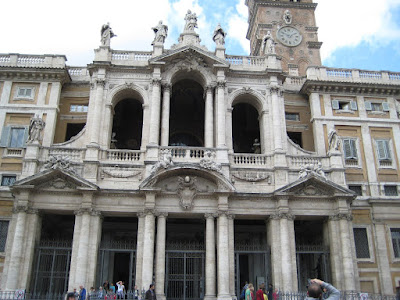The decline and fall of the Roman Empire was gradual over four centuries concluding in 476 when Romulus Augustus, the last Emperor of the Western Roman Empire, was deposed. The Eastern Roman Empire continued until the fall of Constantinople in 1453.
This is Monumento Nazionale a Vittorio Emanuele II (National Monument to Victor Emmanuel II), completed in 1935, it was built to honor the first king of a unified Italy.
Tomb of the Unknown Soldier
From the top of the monument you can see twin churches Santa Maria Di Loreto and Santissimo Nome di Maria al Foro Traiano (Church of the Most Holy Name of Mary at the Trajan Forum) and Trajan's Column.
Marcus Ulpius Nerva Traianus Augustus (better known as just Trajan) was Roman Emperor from 98 AD until his death in 117 AD.

Trajan's Column, completed in 113 CE, commemorates Roman Emperor Trajan's victory in the Dacian wars. It originally had a statue of Trajan at the top, but in 1587, the Pope replaced it with a bronze figure of St. Peter.

The bas relief tells the story of the Roman and Dacian wars (101-102 and 105-106). Dacia was a kingdom from 1st century BC - 2nd century AD in present day Romania and Moldavia.
This is the Mausoleum of Hadrian (Castel Sant'Angelo) on the bank of the Tiber River. Originally built in 135 AD by Hadrian as a mausoleum for himself and his family, it has been used as a fortress, castle and is now a museum.

Publius Aelius Trajanus Hadrianus Augustus (better known as just Hadrian) was Roman Emperor for 20 years between 117-138 AD. Coincidentally, he was the adopted son of Trajan mentioned above.
The River Tiber. For some perspective, those two little black objects on the road by the river are people.

This river runs 252 miles from the Apenine Mountains to the sea.

This is the Roman Hall of Justice - Corte Supreme di Cassazione (Supreme Court of Cassation). It is the court of last resort in Italy.
I just love this picture of the river and the bridge.
This is Basilica di Santa Maria Maggiore.

This is the back of the basilica which I think is more beautiful than the front. It is agreed that this present church was built under Pope Sixtus III (432-440).

The High Altar

This coffered ceiling is said to be gilded with Inca gold presented by Ferdinand and Isabella to the Spanish pope, initially brought by Christopher Columbus.

The is the Crypt of the Nativity or Bethlehem Crypt.

It is said to contain wood from the Holy Crib of the nativity of Jesus Christ.

Un altro grande giorno a Roma.








No comments:
Post a Comment